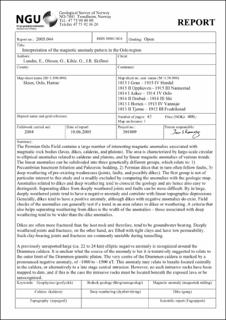| dc.description.abstract | Forkortet:\rThe permian Oslo Field contains a large number of interestin magnetic anomalies associated with magmatic rock bodies (lavas, dikes, calderas, and plutons). The area is characterized by large-scale circular to elliptical anomalies related to calderas and plutons, and by linear magnetic anomalies of various trends. The linear anomalies can be subdivided into three genetically different groups, which relate to: 1) Precambrian basement foliation and Paleozoic bedding, 2) Permian dikes that in turn often follow faults, 3) Deep weathering of pre-existing weaknesses (joints, faults, and possibility dikes). The first group is not of particular interest to this study and is readily excluded by comparing the anomalies with the geologic map. Anomalies related to dikes and deep weathering tend to crosscut the geology and are hence also easy to distinguis. Separating dikes from deeply weathered joints and faults can be more difficult. By in large, deeply weathered joints tend to have a negative anomaly and correlate with linear topographic depressions. Generally, dikes tend to have to have a positive anomaly, although dikes with negative anomalies do exist. Field checks of the anomalies can generally test if a trend in an area relates to dikes or weaathering. A criteria that also helps separating weathering from dikes is the width of the anomalies - those associated with deep weathering tend to be wider than the dike anomalies. | |

